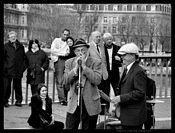The success of The Secret, Dan Brown's The Lost Symbol and the newly released movie Avatar offer strong evidence that everywhere and in every way people are realizing that our planet is composed of interconnected systems of energy and consciousness that extend far beyond the connections that we imagined in the past. At the center of this new understanding is the idea that every thought and everything is a bundle of potential energy, and that thoughts can become things. Unfortunately, this new understanding does not extend to our insights into human behavior. Today's managers, parents and other authority figures have not yet let go of their archaic cause-and-effect ways of thinking about human behavior. Thinking like this leads people to boxing and labeling, diagnosing, treating and quick fixing techniques for influencing the behavior of others. While managers have developed the understanding that stimuli such as needs and desires are inside of us, they have not moved away from stimulus-response thinking. Few have embraced a different way of understanding human behavior known as Perceptual Control Theory, PCT for short. PCT is the human behavior corollary to systems thinking about and understanding of the world around us.
In the late 1950's, William T. Powers recognized that our increasing skill at building mechanical control systems really revealed a deeper understanding of the ins and outs of human behavior. Control systems thinkers realized that a person was, in fact, a closed loop negative feedback system. These thinkers defined behavior as the control of perception. This revolutionary concept has yet to gain widespread understanding and acceptance, and it has yet to lead to a change in thinking about how we manage ourselves and others. Once we understand human behavior through this different paradigm, we recognize that punishments, rewards, threats, guilt, praise, shaming, and bullying are forms of coercion that will not work long term and often create severe damage along the way to the individuals involved, to the relationships between or among them, to the organization of which they are members, and to society as a whole.
Control is a simple process involving action, perception and comparison. Action results when many internal signals trigger the firing of neurons that affect muscles and glands. Typing (which is the action I am taking right now) is created when billions of neurons fire and signal muscles which create movement in my fingers. The only evidence I have that this internal signaling and firing is happening is the perception of letters that form words appearing on the screen. I am controlling for specific letter combinations to appear on the screen in front of me. To know if I am accomplishing this result, I am constantly comparing the letters I see to the letters I desire. I am in a relationship with my environment at all times. I am attempting to create the world I want.
The complexity and interconnection of the system reaches beyond 'me and the environment;' it extends to multiple levels inside of me. On one level I am controlling for specific letter combinations, on a higher level I am control for grammar, punctuation and spelling, and on a higher level yet I am controlling for a message. Just as the roots of a tree interact with the environment in which they are embedded, I interact with the world around me. Moreover, like the tree whose roots are in relationship with the wood, the bark, the branches and the leaves, my system has multiple layers of relationships and interconnections. What at first seems simple becomes more complex, and beyond the complexity, there remains one simple answer to the question: why we do what we do. We do it because at that moment what we want and what we perceive do not match. Conscious awareness of what we want and how we perceive the world are essential ingredients in understanding ourselves and others.
Once we understand and integrate an understanding of PCT into how we live and interact with others and our environment, we view all living systems as bundles of potentiality which are constantly involved in the process of controlling. All we can be to each other is disturbance; a helping or hindering force in the environment. In your relationships with others, which do you want to be? To be a helping force, recognize and seek to understand what the person wants by asking, "What do you want?" Instead of making all sorts of assumptions about what would help, simply ask, "How might I help?" Operating with a PCT attitude embraces the potential within everyone and honors an individual's ability to manifest what he or she desire. The secret to understanding human behavior is to recognize and understand the natural process of control.
Sunday, February 28, 2010
Subscribe to:
Post Comments (Atom)
SEARCH THE WEB

Custom Search







No comments:
Post a Comment